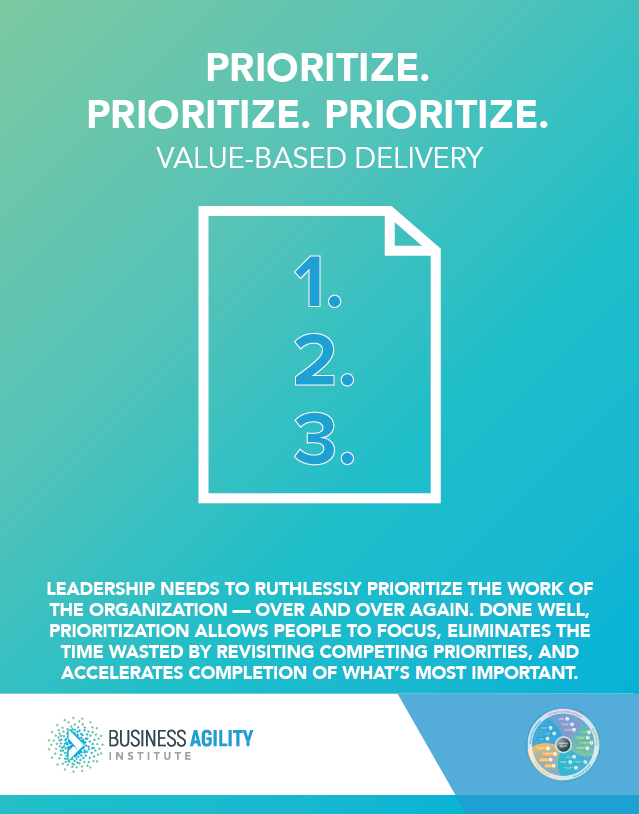Domains of Business Agility
- Responsive Customer-Centricity
- / Fiercely Champion The Customer
- / Sense & Respond Proactively
- / Integrate Diverse Ideas
- Engaged Culture
- / Cultivate A “Learning Organization”
- / Engage Transparently & Courageously
- / Embed Psychological Safety
- / Act As One
- Value-Based Delivery
- / Unleash Workflow Creatively
- / Prioritize. Prioritize. Prioritize.
- / Deliver Value Sooner
- / Seize Emergent Opportunities
- Flexible Operations
- / Adapt Strategies Seamlessly
- / Fund Work Dynamically
- / (Re)Organize Structures Fluidly
- / Balance Governance And Risk
- People-First Leadership
- / Foster Authentic Relationships
- / Empower With Accountability
- / Realize People’s Potential
Just how many “top priorities” can an organization survive? Too much “top-priority” work is among the most crippling challenges faced by organizations. Truly critical work gets lost in the noise of everything else, and as new needs and ideas emerge, the noise only grows. This is how progress stagnates and dies.
Leadership needs to ruthlessly prioritize the work of the organization — over and over again. What is most important? How does it fit with your organization’s current vision, strategies, and goals to benefit customers? Is it consistent and aligned across your organization? Done well, prioritization enables an organization to express great creativity. It allows people to focus, eliminates the time wasted by revisiting competing priorities, and accelerates time to completion on what’s most important. This is what creates capacity for tomorrow’s top priority.
Primary Behaviors
The following 4 behaviors strongly contribute to the ability to prioritize. prioritize. prioritize.
B40: Leaders ruthlessly prioritize what the organization works on: Rather than saying “yes” to everything, leaders constantly prioritize what’s more important for the organization. Leaders say “no” to lower priority options so that the organization can focus on fewer initiatives - enabling quicker completion of the most valuable work.
B41: Leaders continuously (re)prioritize business outcomes & opportunities: Leaders collaborate to prioritize the outcomes the organization is currently working towards. Not everything is “priority #1.” As new information or opportunities become available, priorities for the organization are updated.
B42: Everyone ensures work is aligned to current strategic priorities & goals: To advance the organization's strategic goals as quickly as possible, the day-to-day work of the organization needs to be aligned. With regular strategic reviews, all work made visible, and open lines of communication across the organization - minor course corrections ensure that day-to-day work supports the strategic intent of the organization.
B43: Leaders factor in the organization’s capacity for change and balance accordingly: Leaders monitor the types and degree of change already in process in their organization, as well as historic change-fatigue, when considering launching a new change initiative.


